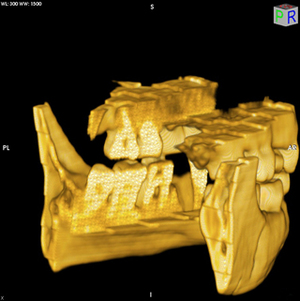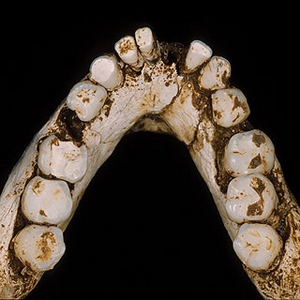And you thought Frodo had it hard. In what is shaping up to be a battle of Tolkienian proportions, the tiny remains from Flores, Indonesia--paleoanthropology's hobbit--have once again come under attack.
Most paleoanthropologists believe that the hobbit belongs to a new species of human, Homo floresiensis. But now comes word that the specimen used to define the species--a largely complete female skeleton known as LB1--appears to have had some dental work. If so, it would mean that, rather than being an 18,000-year-old representative of a new species, the hobbit was just a modern human with a growth disorder that left it with a brain the size of a grapefruit, among other odd traits, which is what critics have argued all along.
Maciej Henneberg, a paleoanthropologist at the University of Adelaide in Australia contends on the basis of photographs that LB1 had a filling--and possibly a root canal--in its lower left first molar (technically known as the M1). He believes the tooth was drilled and the cavity filled with a kind of dental cement that was used by Indonesian dentists in the 1930s.
Henneberg shared the photos he studied with several fellow attendees at the annual meeting of the American Association of Physical Anthropologists held recently in Columbus, Ohio. He pointed out the color of the alleged filling, which differed from that of the enamel. He also noted that the putative filling appeared to be more worn than the surrounding enamel.
Henneberg says he initially made these and other observations three years ago, but did not want to go public until he had a chance to verify them with the original remains. He has yet to see the bones, but decided to air his theory because it has become increasingly apparent that he may never get the opportunity. (A request to do so was denied.)
Hobbit defenders pooh-pooh the claim. Paleoanthropologist Peter Brown of the University of New England in Armidale, Australia, who led the initial analysis of LB1, says his own photograph of the occlusal (chewing) surface "shows there is no filling. There are no dental materials or dentists who can color match and hide a cavity in a molar to the degree that would be necessary."
Brown has also examined CT (computed tomography) scans of LB1's teeth, which reveal normal, bifurcating roots in the M1. "The CT scans, when combined with the detailed occlusal view, totally refute Henneberg's claim," Brown asserts.

|
| ©PETER BROWN University of New England |
| REGULAR ROOTS: Hobbit defenders say this CT scan showing the lower left first molar reveals no signs of the alleged root canal. |
Charles Hildebolt, a paleoanthropologist at Washington University in St. Louis, has also been working on the Flores material and has obtained his own CT scans. "We think that it is highly unlikely that any type of filling material is in the mandibular left first molar," he said in an e-mail. "The defect in the mandibular left first molar does not have the appearance of a cavity preparation made by a dentist in that the defect is shallow, is nonretentive and is not extended in an apical direction interproximally. There is no indication of tooth decay in any of LB1's teeth."
He adds, "if for some reason, a temporary filling were placed in LB1's mandibular left first molar, we should be able to see some indication of it in the CT images, but we cannot--all that we can see is a defect that resembles other defects on LB1's teeth where the enamel has worn away and the dentine is exposed."
Paleoanthropologist John Hawks of the University of Wisconsin-Madison, who was present when Henneberg made his case, notes on his blog that Brown's CT scan "has rather poor resolution (typical of medical CT scans), and cuts through the lingual cusps of the lower M1, not the buccal (cheek) cusps which appear to have been most affected by the irregularity." He says an x-ray would be more convincing.




Reader Comments
to our Newsletter